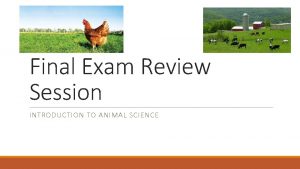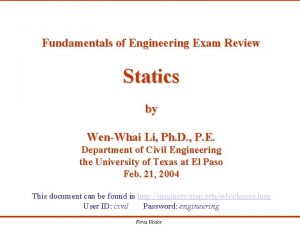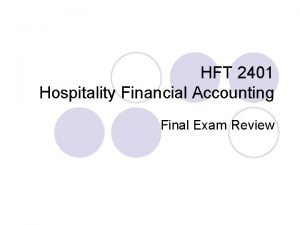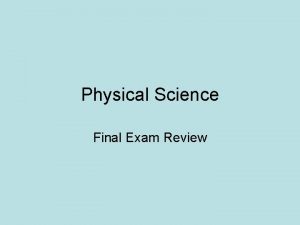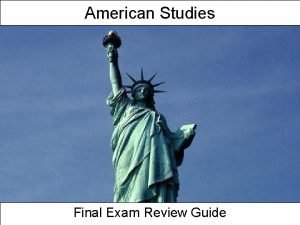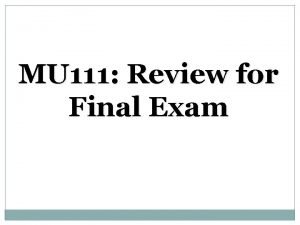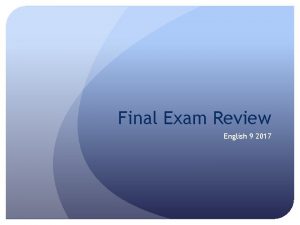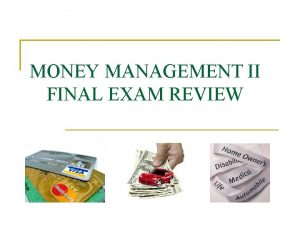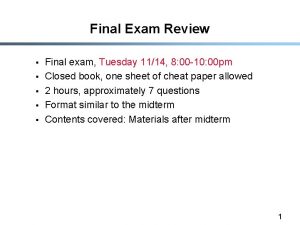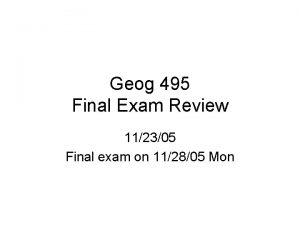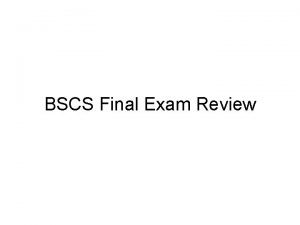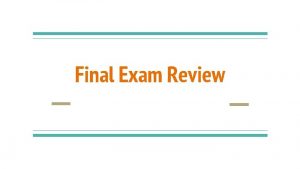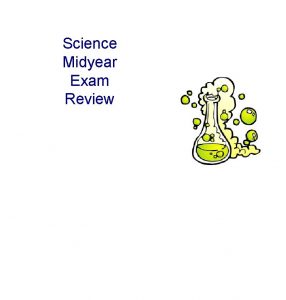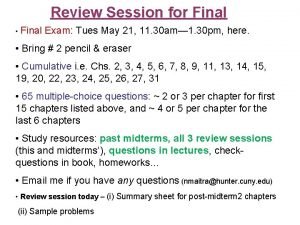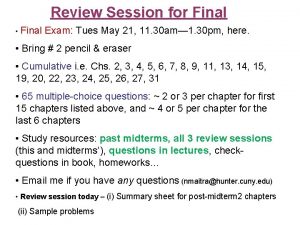Final Exam Review Session INTRODUCTION TO ANIMAL SCIENCE























- Slides: 23

Final Exam Review Session INTRODUCTION TO ANIMAL SCIENCE

Study Tips Review your notes several times ◦ Mix it up! Look at diagrams, charts, tables. Converse with fellow classmates. Make note cards. Study right before sleeping. Do you have any tips for your peers?

Hormones Follicle Stimulating Hormone (FSH) ◦ ◦ Initiates follicular growth (oogenesis) Influence spermatogenesis Synthetic products- Ovagen, Folltropin Location- Anterior Pituitary Luteinizing Hormone (LH) ◦ ◦ Stimulates growth of tissues in gonads that secrete hormones Acts in conjunction with FSH to cause ovulation Causes corpus luteum formation Location- Anterior Pituitary

Hormones Prolactin ◦ ◦ Ovary: maintains functional capacity of the corpus luteum Mammary gland: stimulates formation of milk in the alveoli Causes broodiness in birds Location- Anterior Pituitary Oxytocin ◦ Uterus: stimulates contraction ◦ Mammary gland: initiates let-down of milk into ducts and cisterns ◦ Location- Posterior Pituitary

Hormones Estrogen ◦ ◦ Stimulates growth of accessory reproductive organs and secondary sex characteristics Induces estrus (heat) Mammary gland: stimulates development of the duct system Location- Ovary (follicle) Progesterone ◦ ◦ ◦ Inhibits release of FSH and LH Prepares uterus for implantation Maintains pregnancy Mammary gland: develops alveolar system Synthetic product- CIDR and Regumate Location- Ovary (Corpus Luteum), Placenta

Hormones Relaxin ◦ Relaxes pubic bones and cervix for birth ◦ Location- Cervix Androgen (Testerone) ◦ Stimulates sexual desire ◦ Stimulates growth of accessory reproductive organs and secondary sex characteristics ◦ Location- Testes

Hormones Gonadotrophin-Releasing Hormone (Gn. RH) ◦ Causes release of FSH and LH from anterior pituitary ◦ Synthetic products- Cystorelin, Fertagyl, Factrel, Ova. Cyst ◦ Location- Hypothalmus Prostaglandin F 2 alpha ◦ Causes regression of corpus luteum in sheep, cattle and swine ◦ Synthetic products- Lutalyse, Prosta. Mate, Estrumate, In-Synch, estro. PLAN, Estrumate ◦ Location- Uterus

Reproduction System- Male

Reproductive System- Male Semen= Sperm Cells + Fluids ◦ Fluids from Ampulla, Seminal vesicles, Prostate, Cowper’s Gland What is the functions of seminal fluid? Volume, Increase survival, Increase movement, Provides nutrients, Provides electrolytes, Provides lubrication, and Neutralizing of urinary tract acids Name the parts of the sperm cell below and functions of each:

Reproduction System- Female Gestation Length: Cow: 283 Days Queen (Cat): 52 Doe (Goat): 150 Jill (Mink): 50 Ewe: 150 Bitch (Dog): 60 Doe (Rabbit): 31 Sow: 115 Mare: 346 What are three placental membranes? (Innermost to Outermost) ◦ Amnion ◦ Allantois ◦ Chorion

Cow Reproductive Tract

Digestion Terms Ingesta – after swallowing. Cud – after leaving rumen. Chyme – after leaving the true stomach or only stomach. Digestive End Products (DEPs) – those nutrient ingredients absorbed after digestion. Fecal Material or Non-Digested End Products – lower end of large intestine or large colon. Feces – waste matter removed from the rectum after all digestive processes, and deposited outside the body. VFA’s (Volatile Fatty Acids) represent the major source of energy derived from the feed in a usable form.

Digestive System- Monogastric WHAT IS THE ROUTE FOOD WILL TAKE THROUGH THIS SYSTEM? 1. Mouth 8. Cecum 2. Esophagus 9. Large Intestine 3. Stomach 10. Rectum 4. Small Intestine 11. Anus 5. Duodenum 6. Jejunum 7. Ileum


Disgestive System- Ruminant WHAT IS THE ROUTE THAT FOOD TAKES THROUGH THIS SYSTEM? 1. Mouth 7. Cecum 2. Esophagus 8. Large Intestine 3. Reticulo-rumen (Regurgitated, Rechewed, Reinsalivated, Reswallowed) 9. Rectum 4. Omasum 5. Abomasum 6. Small Intestine Duodenum, Jejunum, Ileum 10. Anus


Digestive System- Birds Mouth – no teeth; therefore coarse feed must move to gizzard. �Fowl break their feed into a size that can be swallowed by pecking with their beaks or by scratching with their feet. � Crop – is an esophageal diverticulum and serves as a storage area for recently digested food. � Proventriculus – is similar to the stomach in carnivorous animals. � Gizzard – primary function is the reduction of the size of food particles by a grinding action. � Pepsin is present, an acid-base activity takes place, along with meager proteolysis.

Digestive System- Birds Small Intestine – digestive activity here is similar as in mammals. Enzymes of the pancreas and the ‘brush border’ aid in digestive activity. Monosaccharides and amino acids are carried by active transport through the gut wall. Fat absorption takes place in lower half of small intestine and enhanced by the presence of bile. � Ceca – most of the fiber digestion takes place here via fermentation. � Large Intestine – concerned with water absorption. � Cloaca – chamber into which the urinary and genital tracts also open into.


Nutrients What are the six nutrients needed? ◦ Protein, Carbohydrates, Fats, Minerals, Vitamins, and Water Feed Classifications: Forages/Roughages- High in Fiber Concentrates- Low in fiber and high in digestible nutrients What are enzymes and what are they used for? They are proteins catalysts that speed up reactions (digestion). Thermal Neutral Zone- an endotherm’s temperature tolerance range. Total Digestible Nutrients- the amount of nutrients that can be absorbed by an animals digestive track.

Problem- Genetics A local farmer wants to breed 40 hens. Howver, the farmer wants to know what offspring he will get from breeding his prize hens. So he takes his hens to the local geneticist and has their genomes analyzed. 10 of his hens are black and are homozygous for yellow feet. 12 of his hens are white and homozygous for blue feet. 18 of his hens are black with white spots and are homozygous for yellow feet. The geneticist tells the farmer that the alleles for black is BB, white is WW, and black with white spots (speckled) is BW. Further more, blue feet are dominant to yellow feet. So, the farmer bought 1 rooster that is Black with yellow feet. What are the genotypes and phenotypes of the chicks the farmer can expect? (Assume only one chick per hen) How many chicks will be in each group? What is the gene frequency of the White allele? Black allele? What is the gene frequency of the Yellow allele? Blue allele?

Problem- Sperm Straws A bull produced 3 ml of semen. The sperm concentration was counted and it was determined that there was 5 billion sperm cells. How many ½ ml straws of semen can be produced if you want each straw to contain 25 million sperm cells?

Ending Note
 Writ of certiorari ap gov example
Writ of certiorari ap gov example Animal science final exam
Animal science final exam Earth science final exam
Earth science final exam Physical science jeopardy
Physical science jeopardy Earth science sol review
Earth science sol review World history spring final exam review answers
World history spring final exam review answers Spanish 1 semester 1 final exam answer key
Spanish 1 semester 1 final exam answer key Human body systems final exam
Human body systems final exam Poe final exam
Poe final exam Ied final exam
Ied final exam World history first semester exam review
World history first semester exam review Principles of business final exam answer key
Principles of business final exam answer key Spanish 2 review packet answers
Spanish 2 review packet answers Apwh final exam review
Apwh final exam review Us history final exam semester 2
Us history final exam semester 2 English 11 semester exam
English 11 semester exam Physics 20 final exam practice
Physics 20 final exam practice Mat 1033 final exam answers
Mat 1033 final exam answers Statics final exam review
Statics final exam review Zoology semester 1 exam review answers
Zoology semester 1 exam review answers Algebra 2 semester 2 final exam
Algebra 2 semester 2 final exam Hft accounting
Hft accounting Personal finance final exam review
Personal finance final exam review Spanish 2 review
Spanish 2 review

